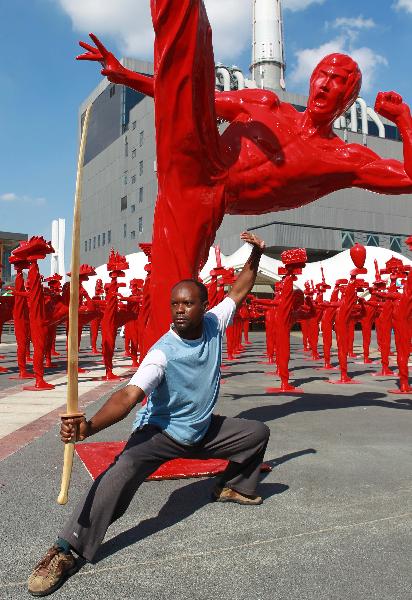Bruce Lee kicks back at the Expo
Kung fu icon Bruce Lee - a powerful figure in shining red ceramic - stands on one leg and kicks the other explosively, almost vertically into the air, balancing the Oriental Pearl TV Tower.
Forty-nine other bright-red Bruce Lees in identical poses balance landmarks from around the world, such as the "Bird's Nest" National Stadium in Beijing, the Arc de Triomph in Paris, the Sydney Opera House, the post-911 World Trade Center site, the Guggenheim Art Gallery, the British Museum and the Burj Dubai hotel.
The idea is that superhero Lee can lift mighty monuments.
The spectacular kick is called the "Foshan shadowless foot" (Foshan wuyingjiao) because the motion is so fast that it is said to have no shadow. Foshan City in Guangdong Province nurtured Lee and other kung fu masters.
The 50 figures, each around two meters high, are a big draw at the world Expo where they are clustered outside the Pavilion of Future in the Urban Best Practices Area. Visitors can stand next to the master and assume their own poses for photographers.
The statues comprise an art installation, "China Kung Fu," by Shu Yong, the winner of the 2007 Florence Biennale Career Award. It combines sculpture with video and performance art.
All sculptures, and the mini monuments, are made of famous ceramic from Foshan, one of the cradles of Chinese ceramics.
Foshan is also significant because of its kung fu history involving Bruce Lee, Wong Fei-hung and Yip Wen.
The installation was sponsored by 1506 Creative City in Foshan; 1506 refers to the date of the early Foshan kilns.
"Some people challenged me saying that this piece is too aggressive," says Shu. "Those who say that don't have a deep knowledge of Chinese kung fu. Chinese martial arts activate one's inner power through body techniques that harmonize with the outside world.
"The highest level of Chinese kung fu is restrained, self-cultivated and profound rather than arbitrary and aggressive."
 0
0 







